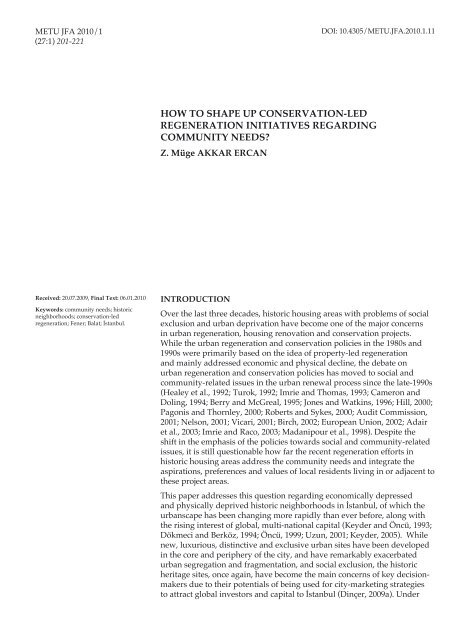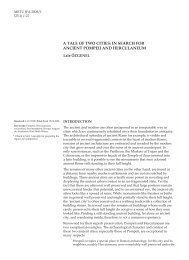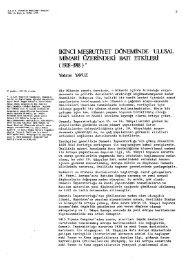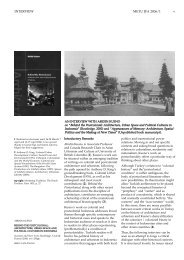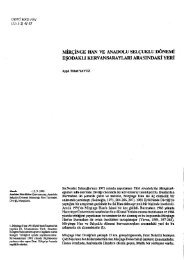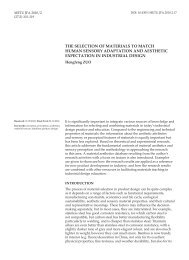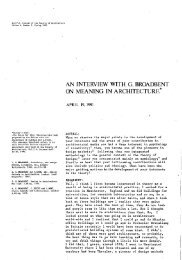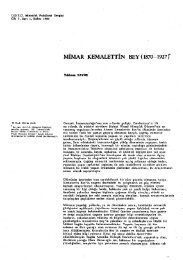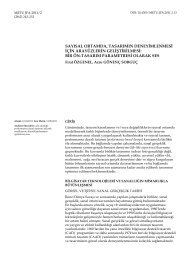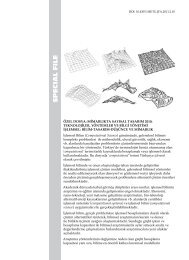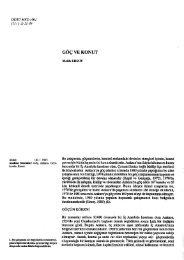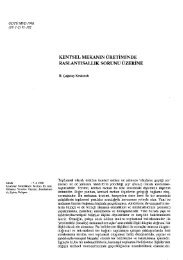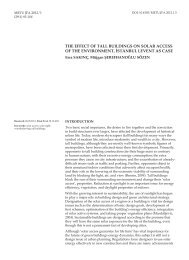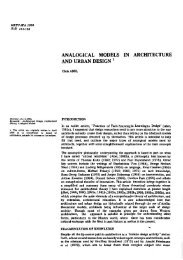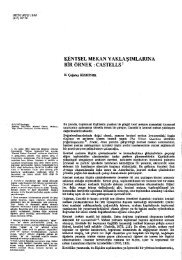how to shape up conservation-led regeneration initiatives regarding ...
how to shape up conservation-led regeneration initiatives regarding ...
how to shape up conservation-led regeneration initiatives regarding ...
Create successful ePaper yourself
Turn your PDF publications into a flip-book with our unique Google optimized e-Paper software.
HOW METU TO JFA SHAPE 2010/1UP<br />
CONSERVATION-LED REGENERATION DOI: METU 10.4305/METU.JFA.2010.1.11<br />
JFA 2010/1 201<br />
(27:1) 201-221<br />
Received: 20.07.2009, Final Text: 06.01.2010<br />
Keywords: community needs; his<strong>to</strong>ric<br />
neighborhoods; <strong>conservation</strong>-<strong>led</strong><br />
<strong>regeneration</strong>; Fener; Balat; İstanbul.<br />
HOW TO SHAPE UP CONSERVATION-LED<br />
REGENERATION INITIATIVES REGARDING<br />
COMMUNITY NEEDS?<br />
Z. Müge AKKAR ERCAN<br />
INTRODUCTION<br />
Over the last three decades, his<strong>to</strong>ric housing areas with problems of social<br />
exclusion and urban deprivation have become one of the major concerns<br />
in urban <strong>regeneration</strong>, housing renovation and <strong>conservation</strong> projects.<br />
While the urban <strong>regeneration</strong> and <strong>conservation</strong> policies in the 1980s and<br />
1990s were primarily based on the idea of property-<strong>led</strong> <strong>regeneration</strong><br />
and mainly addressed economic and physical decline, the debate on<br />
urban <strong>regeneration</strong> and <strong>conservation</strong> policies has moved <strong>to</strong> social and<br />
community-related issues in the urban renewal process since the late-1990s<br />
(Healey et al., 1992; Turok, 1992; Imrie and Thomas, 1993; Cameron and<br />
Doling, 1994; Berry and McGreal, 1995; Jones and Watkins, 1996; Hill, 2000;<br />
Pagonis and Thornley, 2000; Roberts and Sykes, 2000; Audit Commission,<br />
2001; Nelson, 2001; Vicari, 2001; Birch, 2002; European Union, 2002; Adair<br />
et al., 2003; Imrie and Raco, 2003; Madanipour et al., 1998). Despite the<br />
shift in the emphasis of the policies <strong>to</strong>wards social and community-related<br />
issues, it is still questionable <strong>how</strong> far the recent <strong>regeneration</strong> efforts in<br />
his<strong>to</strong>ric housing areas address the community needs and integrate the<br />
aspirations, preferences and values of local residents living in or adjacent <strong>to</strong><br />
these project areas.<br />
This paper addresses this question <strong>regarding</strong> economically depressed<br />
and physically deprived his<strong>to</strong>ric neighborhoods in İstanbul, of which the<br />
urbanscape has been changing more rapidly than ever before, along with<br />
the rising interest of global, multi-national capital (Keyder and Öncü, 1993;<br />
Dökmeci and Berköz, 1994; Öncü, 1999; Uzun, 2001; Keyder, 2005). While<br />
new, luxurious, distinctive and exclusive urban sites have been developed<br />
in the core and periphery of the city, and have remarkably exacerbated<br />
urban segregation and fragmentation, and social exclusion, the his<strong>to</strong>ric<br />
heritage sites, once again, have become the main concerns of key decisionmakers<br />
due <strong>to</strong> their potentials of being used for city-marketing strategies<br />
<strong>to</strong> attract global inves<strong>to</strong>rs and capital <strong>to</strong> İstanbul (Dinçer, 2009a). Under
202 METU JFA 2010/1<br />
1. The data obtained from the interviewees is<br />
s<strong>how</strong>n and referenced throughout the article<br />
within brakets, such as (the local coordina<strong>to</strong>r,<br />
the direc<strong>to</strong>r of the res<strong>to</strong>ration projects, the<br />
project coordina<strong>to</strong>r of the social centre).<br />
Z. MüGE AKKAR ERCAN<br />
the pressure of <strong>conservation</strong>-<strong>led</strong> <strong>regeneration</strong> strategies aiming <strong>to</strong> create<br />
exclusive and distinctive places for <strong>to</strong>urists, visi<strong>to</strong>rs, potential residents and<br />
service sec<strong>to</strong>r office workers, communities living in the deprived his<strong>to</strong>ric<br />
neighborhoods where poverty, unemployment and crime rates are very<br />
high, and where living conditions, education and health services are very<br />
poor have been forced <strong>to</strong> move out of these sites without being addressed<br />
their problems. Nevertheless, there are also cases s<strong>how</strong>n as exceptional<br />
from these recent strategies, such as Fener and Balat (F&B), a his<strong>to</strong>ric<br />
housing quarter inhabited by poor immigrants and located in the his<strong>to</strong>rical<br />
peninsula of İstanbul some parts of which were inscribed on UNESCO<br />
World Heritage List in 1985.<br />
This paper examines the recent European Union (EU)-funded <strong>conservation</strong><strong>led</strong><br />
<strong>regeneration</strong> initiative <strong>to</strong> assess <strong>how</strong> far the scheme has met the needs,<br />
aspirations and values of the local community. The paper initially defines<br />
the concept of ‘community needs’, identifies the key issues of community<br />
needs in deprived his<strong>to</strong>ric neighborhoods and then, briefly mentions urban<br />
<strong>conservation</strong> and community-related policies in Turkey. Later, focusing<br />
on F&B, it introduces the case study area, defines the community needs in<br />
the mid-1990s, and then assesses the effectiveness or success of the recent<br />
<strong>regeneration</strong> project in serving the community needs. Finally, debating on<br />
the strengths and weaknesses of the scheme, the paper tries <strong>to</strong> highlight<br />
the necessary requirements <strong>to</strong> <strong>shape</strong> <strong>up</strong> <strong>conservation</strong>-<strong>led</strong> <strong>regeneration</strong><br />
<strong>initiatives</strong> <strong>regarding</strong> community needs in deprived his<strong>to</strong>ric districts of<br />
Turkey.<br />
The case study of this research is based on the qualitative and quantitative<br />
data that were gathered from reports, newspaper cuttings, academic<br />
articles and researchers, census data of 1990, 1997 and 2000, in-depth<br />
interviews and direct observations. In-depth and focused interviews were<br />
conducted in 2006 with the key ac<strong>to</strong>rs of the F&B <strong>regeneration</strong> initiative<br />
and other major stakeholders involved in the scheme. The interviews<br />
with the key ac<strong>to</strong>rs of the project were carried out with the local authority<br />
officers (the Fatih Municipality officer responsible for the <strong>regeneration</strong><br />
project and an officer from the Public Education Direc<strong>to</strong>rate of the Fatih<br />
District), the officers from the technical team of the project (the local<br />
coordina<strong>to</strong>r, the direc<strong>to</strong>r of the res<strong>to</strong>ration projects, the project coordina<strong>to</strong>r<br />
of the social centre), the consultants of the project (the local consultant<br />
and co-direc<strong>to</strong>r of the feasibility study undertaken by Fatih Municipality,<br />
the EU, UNESCO and the French Institute for Ana<strong>to</strong>lian Studies in 1997-<br />
1998). A voluntary gro<strong>up</strong> working in the area (the general secretary of<br />
the Balat Beautification Association), teachers (the Principal of Tarık Us<br />
Primary School and a teacher voluntarily working in the Yusuf Şücaaddin<br />
Mosque study hall), ten local tradesmen and ten local residents were other<br />
informants representing the major stakeholders involved in the project<br />
(1). Additionally, the study particularly uses two researches as secondary<br />
data, since both studies were the only latest resources about F&B before<br />
the <strong>regeneration</strong> initiative was launched. The first one was conducted<br />
by Foundation for the S<strong>up</strong>port of Women’s Work (FSWW) in 2004 <strong>to</strong><br />
determine the problems, priorities, and needs of the case study area. The<br />
research is based on the results of 300 questionnaires with local women and<br />
those of 211 interviews with mukthars (headmen), the Balat Beautification<br />
Association, the Fener Volunteers Association, school principals and local<br />
people. The other research used as secondary data, was conducted by<br />
Fatih Municipality, UNESCO, the EU and the French Ana<strong>to</strong>lian Research<br />
Institute in 1998 <strong>to</strong> pinpoint the problems, needs and solutions for the
HOW TO SHAPE UP CONSERVATION-LED REGENERATION METU JFA 2010/1 203<br />
case study area. This study was mainly based on a research conducted by<br />
Narlı (1997) on 236 households in the case study area in 1997, and a further<br />
study carried out in order <strong>to</strong> establish the ownership pattern of the area,<br />
including data from around 2,578 houses.<br />
DEFINING ‘COMMUNITY NEEDS’ AND THE KEY ISSUES FOR<br />
COMMUNITY NEEDS IN DEPRIVED HISTORIC NEIGHBORHOODS<br />
Community, an old concept which comes from a Latin term ‘communis’,<br />
signifies “common, general, joint” (Online Dictionary). Due <strong>to</strong> its elusive<br />
nature, it has been debated for so long that there are now probably well<br />
over a hundred discrete definitions of community (Blackman, 1995; Mayo,<br />
1994; Shaw, 2007). In recent literature, “the most conventional approach<br />
relates <strong>to</strong> people sharing a geographical area (typically a neighborhood),<br />
an idea captured in references <strong>to</strong> local communities” (Crow, 2007), as<br />
also cal<strong>led</strong> ‘place-bound or terri<strong>to</strong>rial communities’ by Blackman (1995)<br />
or ‘community of locality’ by Shaw (2007). ‘Non place-bound’ or ‘nonterri<strong>to</strong>rial’<br />
communities <strong>how</strong>ever are based on shared identities, behaviors,<br />
interests and experiences which are not necessarily place-bound, and which<br />
can be related <strong>to</strong> racial, social, cultural, religious and class differences<br />
(Hedges and Kelly, 1992; Coombes et al., 1992; Blackman, 1995; CTB, 2005;<br />
Crow, 2007; Shaw, 2007). Blackman (1995) defines such gro<strong>up</strong>s as “local<br />
populations identifiable from their wider society by a more intense sharing<br />
of concerns (a community of interest) or by increased levels of interaction<br />
(an attachment community)”. Non place-bound communities have<br />
recently been emerging with the growing fragmentation of society. Hence,<br />
cities have become places where many communities have overlapped.<br />
Nevertheless, place-bound communities have continued <strong>to</strong> be important in<br />
the lives of many people, particularly women and children, older people,<br />
the unemployed and people without cars, who are often priority gro<strong>up</strong>s for<br />
urban policy and public services generally.<br />
As for ‘need’, which is a term for “essential human requirements” and<br />
“necessities for subsistence”, it has been defined in relation <strong>to</strong> society<br />
and community since the Ancient Greek period by Pla<strong>to</strong> and Aris<strong>to</strong>tle,<br />
Enlightenment thinkers, Hegel and Marx, and in the 20th century, by<br />
sociologists, epidemiologists, health economists, educational theorists,<br />
<strong>to</strong>wn planners, social workers and civil servants (Springborg, 2002; Billings<br />
and Cowley, 1995). With the imaginative work of Ignatieff (1984), theorists<br />
have once more focused on the problem of needs for the ‘have-nots’ such as<br />
the poor and the homeless, whose needs are desperate. ‘Community need’,<br />
mainly initiated from the idea of ‘have-nots’, can be defined as “necessities<br />
that specifically relate <strong>to</strong> a particular gro<strong>up</strong> or community”. It is usually<br />
neither a universal need, such as the need for food or affection, nor an<br />
individual need, such as need for a vacation (CTB, 2005). It is thus the<br />
concern of a particular community or gro<strong>up</strong>, and is perceived by a gro<strong>up</strong> as<br />
community issue or problem. Community needs may take many different<br />
forms, ranging from garbage on the streets <strong>to</strong> vandalism, or from s<strong>to</strong>res<br />
moving out of the community <strong>to</strong> ethnic or racial conflict.<br />
For the <strong>conservation</strong> and <strong>regeneration</strong> of deprived neighborhoods of<br />
his<strong>to</strong>ric sites, one way of identifying the key issues of community needs<br />
is <strong>to</strong> discover the problems of local communities. Although the problems<br />
and needs of communities vary from one locality <strong>to</strong> another, it is possible<br />
<strong>to</strong> identify common issues related <strong>to</strong> the community needs, since many<br />
neighborhoods become stuck in a spiral decline as a result of a number
204 METU JFA 2010/1<br />
2. There are extensive studies on the causes<br />
of deprivation and decline in urban areas<br />
(Power, 1996; Taylor, 1998; Costa Pinho,<br />
2000; Gibb et al., 1999; Morrison, 1999; Lee &<br />
Murie, 1999; Power and Tunstall, 1995; Hall,<br />
1997; Morrison, 2003).<br />
Z. MüGE AKKAR ERCAN<br />
of fac<strong>to</strong>rs (2). The move of inhabitants and economic activities out of<br />
these neighborhoods, the deterioration of quality of urban space and life,<br />
as well as the decline in the provision of public services can bring about<br />
a trend of neighborhood decline. The deterioration of listed buildings,<br />
and the difficulties in res<strong>to</strong>ring these buildings due <strong>to</strong> disagreement<br />
among shareholders, complexities of legal <strong>conservation</strong> procedures,<br />
high costs of res<strong>to</strong>ration, and other fac<strong>to</strong>rs exacerbate the neighborhood<br />
decline in heritage sites. All these changes generally result in an increase<br />
in the number of derelict properties and a decline in property values<br />
and rents. These neighborhoods in general become attractive for either<br />
low income gro<strong>up</strong>s like poor immigrants or homeless people. This<br />
worsens neighborhood decline, as low-income dwellers cannot afford the<br />
renewal or res<strong>to</strong>ration costs of houses in which they live. Equally, social<br />
cohesion does not appear <strong>to</strong> emerge or develop due <strong>to</strong> a rapid turnover of<br />
inhabitants of such neighborhoods (Power and Tunstall, 1995). As people<br />
move out, the high turnover and the number of empty homes create more<br />
opportunities for crime, vandalism and drug dealing (Wallace, 2001). Such<br />
neighborhoods in heritage sites are characterized by high unemployment<br />
among residents, unqualified labor power, poor education, higher than<br />
average health problems and a continuous increase in crime rates.<br />
Equally, the recently developed urban policy gives clues in<strong>to</strong> the possible<br />
key issues in terms of community needs. Conserving and protecting<br />
his<strong>to</strong>ric heritage, maintaining civil peace, raising standards in education,<br />
giving people access <strong>to</strong> reasonable housing, ensuring cooperative working<br />
between health and social services, strengthening sustainable development<br />
and improving the environment quality have become the key issues of<br />
the 1990s’ urban policy <strong>to</strong> regenerate deprived neighborhoods in his<strong>to</strong>ric<br />
housing sites (Hill, 2000; Cullingworth and Nadin, 2006). Housing,<br />
employment, health, education, crime and environmental quality, along<br />
with the <strong>conservation</strong> of his<strong>to</strong>ric environment, thus appear <strong>to</strong> be the major<br />
issues while examining community needs in deprived neighborhoods<br />
(Akkar Ercan, 2009). As Wallace (2001) points out, neighborhood decline<br />
is not only an outcome of local dynamics, but also of government policies<br />
which are not sufficient for the tackling of decline problems. Prior <strong>to</strong> the<br />
presentation of the case study, therefore, it will be useful <strong>to</strong> overview the<br />
government policies over the Republican period <strong>to</strong> understand <strong>how</strong> far the<br />
policy agenda of urban <strong>conservation</strong> has addressed the community-related<br />
issues in Turkey.<br />
URBAN CONSERVATION AND COMMUNITY-RELATED<br />
POLICIES IN TURKEY<br />
Despite a remarkable wealth of his<strong>to</strong>ric buildings in Turkey, several<br />
fac<strong>to</strong>rs, such as the cost of maintenance, the lack of fundings from public<br />
institutions <strong>to</strong> private owners of his<strong>to</strong>ric buildings, the rapid urbanization,<br />
have threatened buildings and sites which are of architectural and his<strong>to</strong>ric<br />
interest. As such, the understanding of ‘what his<strong>to</strong>ric is’, or ‘what is<br />
worthy of <strong>conservation</strong>’, and ‘<strong>how</strong> it should be conserved’ has played a<br />
considerable role in shaping urban <strong>conservation</strong> policies. From the early-<br />
1920s <strong>to</strong> the 1970s, the widespread understanding of urban <strong>conservation</strong><br />
was based on the idea of preserving his<strong>to</strong>ric assets individually (Akçura,<br />
1972; Gülersoy, et al, 2000; BİB, 2009). Just after The Amsterdam<br />
Declaration (1975), in 1976, statu<strong>to</strong>ry recognition of the ‘area’ concept<br />
was introduced by the Law No. 1710 (The Law of Immovable Assets
HOW TO SHAPE UP CONSERVATION-LED REGENERATION METU JFA 2010/1 205<br />
and His<strong>to</strong>rical Art); the <strong>conservation</strong> areas were classified as his<strong>to</strong>ric,<br />
archaeological and natural; and the term of ‘urban <strong>conservation</strong> site’ was<br />
introduced in<strong>to</strong> the <strong>conservation</strong> agenda of the country (Gülersoy et al.,<br />
2000; Altunbaş, 2009). In 1983, the Law No. 2863 enforced local authorities<br />
<strong>to</strong> develop <strong>conservation</strong> plans for his<strong>to</strong>ric sites (BIB, 2009). In the late-<br />
1970s, following The Amsterdam Declaration (1975) and the UNESCO<br />
Recommendation concerning the safeguarding and contemporary role of<br />
his<strong>to</strong>ric areas (1976), the ‘integrated <strong>conservation</strong>’ approach, based on the<br />
idea of considering the his<strong>to</strong>ric, archaeological, architectural dimensions,<br />
along with social and economic aspects of revitalizing the urban areas<br />
worthy of <strong>conservation</strong>, began <strong>to</strong> be seen as a necessary approach<br />
<strong>to</strong> his<strong>to</strong>ric sites; and the idea <strong>to</strong>ok its place even in the 4th Five Year<br />
Development Plan, covering the period of 1979-1983 (Gülersoy et al., 2000;<br />
Şahin Güçhan and Kurul, 2009). Also influenced by the trends in Europe,<br />
the <strong>conservation</strong> plans for some his<strong>to</strong>ric places, accompanied by restricting<br />
buildings codes, were prepared (Gülersoy et al, 2000). These efforts<br />
<strong>how</strong>ever had not become common practices.<br />
Off the recent legislations, The Law No. 5226 (The Law of Protecting<br />
Cultural and Natural Assets) that came in<strong>to</strong> force in July 2004 was<br />
revolutionary in terms of approaching urban <strong>conservation</strong> sites. The Law<br />
broadened the content of ‘<strong>conservation</strong> plans’, making extensive studies<br />
on <strong>conservation</strong> sites compulsory, prior <strong>to</strong> plan preparation (Dinçer,<br />
2009a). These studies were <strong>to</strong> regard <strong>conservation</strong> sites not only their<br />
archeological, his<strong>to</strong>ric, natural, architectural and demographic dimensions,<br />
but also their cultural, social and economic dimensions (Dinçer, 2009a). The<br />
expected outcomes of such studies therefore were <strong>to</strong> be <strong>conservation</strong> plans<br />
integrating multi-dimensional problems of localities; i.e. plans addressing<br />
not only the problems of <strong>conservation</strong> of physical environments, but also<br />
responding <strong>to</strong> the needs of communities living and working, and providing<br />
collaborative planning models, financial, organization and management<br />
models for the planning process (Dinçer, 2009a). The Law also introduced<br />
new financial devices for private owners, as well as the new concepts,<br />
such as ‘management area’, and ‘management plan’, in<strong>to</strong> the <strong>conservation</strong><br />
agenda of the country (Dinçer, 2009b). Additionally, it established new<br />
specialist offices cal<strong>led</strong> Conservation Implementation and Control Bureau<br />
(KUDEB) at metropolitan and district municipalities, and provincial<br />
government offices. KUDEBs, employing experts in the areas of art his<strong>to</strong>ry,<br />
architecture, city planning, archaeology and engineering sciences, were<br />
<strong>to</strong> be responsible for managing and controlling the implementation of<br />
<strong>conservation</strong> plans (Dinçer, 2009b).<br />
The Law No. 5366 (The Law of Preservation by Renovation and Utilization<br />
by Revitalization of Deteriorated Immovable His<strong>to</strong>rical and Cultural<br />
Properties), enacted in July 2005, brought this progressive understanding<br />
back <strong>to</strong> the old state. It has enab<strong>led</strong> the Council of Ministers <strong>to</strong> designate<br />
‘urban renewal sites’, while giving local authorities a great deal of<br />
authority on these areas by making them responsible for preparing<br />
renewal plans outside the conventional planning system without looking<br />
for any reference <strong>to</strong> vision or strategy plans of cities (Dinçer, 2009a).<br />
The Law has fai<strong>led</strong> in providing financial s<strong>up</strong>port <strong>to</strong> private owners <strong>to</strong><br />
repair their houses. Yet, aiming <strong>to</strong> accelerate the process of protecting<br />
cultural and his<strong>to</strong>ric heritage, it has eased the process of expropriation<br />
and bureaucratic issues at the expense of jeopardizing property rights<br />
of private owners (Dinçer, 2009a). In case private owners were not able<br />
<strong>to</strong> afford the res<strong>to</strong>ration costs of their properties, the Law enab<strong>led</strong> local
206 METU JFA 2010/1<br />
Figure 1. The location of the Fener and<br />
Balat Quarter in İstanbul (left above) and<br />
in his<strong>to</strong>rical peninsula (left below), and<br />
the boundary of the recent EU-funded<br />
<strong>regeneration</strong> project (right).<br />
Z. MüGE AKKAR ERCAN<br />
authorities <strong>to</strong> expropriate the his<strong>to</strong>ric buildings, and even <strong>to</strong> sell them <strong>to</strong><br />
the third parties. In this sense, it has brought about not only a high risk<br />
of violation of property rights for the owners of his<strong>to</strong>ric buildings, but<br />
also the rise of gentrification (Dinçer, 2009a). Finally, the <strong>conservation</strong> of<br />
the his<strong>to</strong>ric environment has been the major motivation of the Law that<br />
has not included any article about social and economic dimensions of<br />
designated renewal sites. All in all, except considerable progress in the<br />
1970s understanding of urban <strong>conservation</strong> in Turkey, and the Law No.<br />
5226, the community-related policies have never come <strong>to</strong> a priority issue in<br />
the policy agenda of urban <strong>conservation</strong>, whilst protecting and conserving<br />
his<strong>to</strong>ric urbanscape has been the major concern.<br />
The F&B Quarter is one such his<strong>to</strong>ric site where the <strong>conservation</strong> of<br />
his<strong>to</strong>ric urbanscape has been kept in priority by the <strong>regeneration</strong> <strong>initiatives</strong><br />
<strong>to</strong> enhance the his<strong>to</strong>ric and cultural image of İstanbul, <strong>to</strong> improve the<br />
attractiveness of the site <strong>to</strong> inward investment, the affluent, and <strong>to</strong>urists <strong>to</strong><br />
the area, thereby bolstering economic and urban <strong>regeneration</strong>, and raising<br />
the city’s competitive position in global urban markets. Hence, in many<br />
senses, F&B may be perceived as ‘textbook’ examples of <strong>conservation</strong> of<br />
his<strong>to</strong>ric urbanscape, <strong>to</strong> become place-marketing <strong>to</strong>ols and catalysts of urban<br />
<strong>regeneration</strong>. But equally, several aspects of the Quarter’s recent experience<br />
stand out as distinctive, not least the fact that the recent EU-funded<br />
<strong>regeneration</strong> initiative has been s<strong>how</strong>n as an exemplary <strong>to</strong> implement<br />
further community-based <strong>regeneration</strong> projects in deprived his<strong>to</strong>ric<br />
districts of Turkey by UNESCO World Heritage Centre and ICOMOS<br />
(2008). F&B are also good examples in terms of assessing the effectiveness<br />
or success of the <strong>regeneration</strong> initiative in accordance with community<br />
needs due <strong>to</strong> the availability of the extensive data and researches on the
HOW TO SHAPE UP CONSERVATION-LED REGENERATION METU JFA 2010/1 207<br />
Figure 2. The land-use map of the Fener and<br />
Balat Quarter in 2005.<br />
local residents’ problems, priorities and needs before the recent scheme<br />
was launched. The following section introduces the F&B Quarter, and<br />
examines the community needs and aspirations in the mid-1990s, prior <strong>to</strong><br />
the launch of the recent <strong>regeneration</strong> initiative.<br />
THE FENER AND BALAT QUARTER<br />
Surrounded by Byzantine walls from the 5th century AD <strong>to</strong> the west and<br />
the Golden Horn <strong>to</strong> the north, F&B are located on the his<strong>to</strong>ric peninsula of<br />
İstanbul (Figure 1). The his<strong>to</strong>ry of the Quarter goes back <strong>to</strong> the Byzantine<br />
period. Fener, being the home of the Greek Patriarchate and the centre of<br />
the Orthodox Church, was known <strong>to</strong> be predominantly an <strong>up</strong>per-class<br />
Greek neighborhood from the Ot<strong>to</strong>man period <strong>to</strong> the 1960s (Belge, 2003;<br />
Özbilge, 2005). Balat, mostly inhabited by Jews, with some Armenian,<br />
Greek and Muslim dwellers was a vibrant hub for fishery and port<br />
management before the 19 th century (Belge 2003; Özbilge 2005). The move<br />
of the wealthy inhabitants of the Quarter in the 1960s and their replacement<br />
with poor immigrants, along with the contamination and pollution of the<br />
Golden Horn, <strong>led</strong> <strong>to</strong> the dilapidation of F&B (Özbilge 2005). Between 1984<br />
and 1987, the coastal area was cleared with large-scale demolition, and a<br />
park and a road were built along the shore of the Golden Horn (Özbilge<br />
2005). Despite the clearing of the coastline, the Quarter kept deteriorating.<br />
Today, F&B, surrounded by and comprising a number of monumental<br />
buildings, such as churches, mosques and synagogues, and distinctive with<br />
their 19 th -century grid-iron plan and hewn-s<strong>to</strong>ne ‘row houses’ with bay
208 METU JFA 2010/1<br />
Figure 3. Row houses with bay windows as<br />
one of the major characteristics of Fener and<br />
Balat (M. Akkar Ercan).<br />
Figure 4. Examples from the buildings in<br />
ruins in the Fener and Balat Quarter in 2006<br />
(S. Duzcu).<br />
Z. MüGE AKKAR ERCAN<br />
windows and richly ornamented facades, are under grave threat of decline<br />
(Figure 2-4). This residential quarter accommodates 12 listed monuments<br />
and 508 listed buildings comprising almost 40% of the <strong>to</strong>tal building s<strong>to</strong>ck<br />
in the area (Fatih Municipality et al, 1998). Another important his<strong>to</strong>ric<br />
heritage is the 16th-century Balat Market, which is located on the west of<br />
the site, specializes in glass and shoe manufacturers, hardware shops and<br />
other kinds of crafts, giving the area the appearance of a bazaar. Close <strong>to</strong><br />
the Balat Market, there are banks, restaurants and shops selling electrical<br />
appliances and furniture. Also, hotels and souvenir shops for <strong>to</strong>urists have<br />
recently been mushrooming in the area around the Greek Patriarchate.<br />
The Quarter is densely populated. In 2000, the <strong>to</strong>tal population living in<br />
F&B was 36,158, 39% of which constituted children and teenagers (TSI,<br />
2000 Census Data). The community included immigrants dominantly from
HOW TO SHAPE UP CONSERVATION-LED REGENERATION METU JFA 2010/1 209<br />
Starting from the 19 th century <strong>to</strong> <strong>to</strong>day,<br />
various urban transformation interventions<br />
have appeared in order <strong>to</strong> solve the problems<br />
of urban deprivation and decline in both<br />
Western and Turkish cities (Akkar, 2006).<br />
Urban renewal, urban reconstruction, urban<br />
development and redevelopment, urban<br />
improvement, urban rehabilitation, urban<br />
preservation, urban <strong>conservation</strong>, infill<br />
development, urban refurbishment, urban<br />
(re)strengthening and urban relocation<br />
are some of these urban transformation<br />
interventions emerged within the last two<br />
centuries (Akkar, 2006). This article considers<br />
The Rehabilitation of F&B Districts Program<br />
as a ‘<strong>conservation</strong>-<strong>led</strong> <strong>regeneration</strong>’ project<br />
and assesses its capacity of responding <strong>to</strong><br />
community needs, values and aspirations<br />
accordingly. The term of ‘rehabilitation’<br />
was chosen delibarately for the EU-funded<br />
scheme <strong>to</strong> provide an alternative way of<br />
regenerating of a his<strong>to</strong>ric residential site by<br />
conserving both the his<strong>to</strong>ric and cultural<br />
values and local community, instead of<br />
turning such sites in<strong>to</strong> res<strong>to</strong>red <strong>to</strong>urist<br />
attractions (Fatih Municipality et al., 1998).<br />
This idea behind the F&B rehabilitation<br />
program, in general, coincides with the<br />
essence of ‘<strong>conservation</strong>-<strong>led</strong> <strong>regeneration</strong><br />
projects’ that seek <strong>to</strong> link <strong>conservation</strong><br />
with wider social and economic benefits; in<br />
particular <strong>regeneration</strong>, but also, for example,<br />
issues of sustainability and excellence in<br />
new architectural design (Pendlebury, 2002;<br />
Cullingworth & Nadin, 2006). Equally<br />
important <strong>to</strong> note for the F&B Rehabilitation<br />
Program is that the scheme was prepared<br />
and launched before the Laws No. 5226 and<br />
5366; ie. a period of time there was no strong<br />
legal basis for such urban rehabilitation<br />
projects in Turkey.<br />
the Black Sea Region (Fatih Municipality et al. 1998; FSWW 2004). Family<br />
ties and kinship were found <strong>to</strong> be very strong. The majority of families<br />
(62%) were made <strong>up</strong> of four or five people with the father-mother-children<br />
family unit being the most widespread family type, while a significant<br />
number of the families shared their houses with parents or relatives (Fatih<br />
Municipality et al., 1998; FSWW 2004). Most inhabitants are economically<br />
poor. While the poverty line for a family of four was €261.59 per month<br />
in Turkey in 2004, 46% of the families of F&B earned less than €243.90<br />
monthly (FSWW, 2004). Most families spent almost all of their income<br />
on domestic needs (food, rent, heating and health expenditure), whereas<br />
some were unable <strong>to</strong> afford the cost of heating, rent, education or food<br />
(FSWW, 2004). The majority of the residents were tenants. Despite the<br />
presence of high ratio of tenants (60%), allegiance <strong>to</strong> the neighborhood<br />
was found <strong>to</strong> be high among the residents. According <strong>to</strong> a survey held in<br />
the late-1990s, 75% of the inhabitants expressed their desire <strong>to</strong> continue<br />
living in the area if a <strong>regeneration</strong> project was launched, and if their living<br />
conditions and economic levels were improved (Fatih Municipality et al.,<br />
1998). Low rents, proximity <strong>to</strong> the city centre and the presence of neighbors<br />
or countrymen were the key reasons given for this preference (FSWW,<br />
2004). To the same study, the majority of the inhabitants complained<br />
about the low quality of life in the Quarter, and ranked nine issues that<br />
should be addressed, from the most <strong>to</strong> the least urgent as: 1) res<strong>to</strong>ration<br />
of the buildings and improvement in living conditions; 2) provision of<br />
natural gas in<strong>to</strong> the district; 3) improvement of streets and the removal of<br />
traffic problems; 4) construction of parks and green spaces; 5) provision of<br />
regular street cleaning and garbage collection services; 6) improvement in<br />
the drainage system in order <strong>to</strong> prevent flooding in winter; 7) demolition<br />
of the highly dilapidated buildings for health and safety reasons and the<br />
reconstruction of new ones; 8) robust solution <strong>to</strong> remedy the environmental<br />
pollution (especially air pollution caused by the burning of low-quality<br />
coal in s<strong>to</strong>ves); 9) solutions <strong>to</strong> clean the Golden Horn (Fatih Municipality<br />
et al., 1998). The local community was in poor health due <strong>to</strong> numerous<br />
fac<strong>to</strong>rs related <strong>to</strong> the environmental and physical conditions of the area.<br />
The prominent ones were the side-by-side <strong>to</strong>ilets and bathrooms in the<br />
houses, the accumulation of garbage in the streets, flooding in winter due<br />
<strong>to</strong> the inadequacy of the drainage system, heat insulation problems in the<br />
houses and unclean drinking water (Fatih Municipality et al., 1998; FSWW,<br />
2004). High unemployment among residents, unqualified labor power,<br />
poor education and health services, high crime rates, security and safety<br />
problems were other prominent community-related issues <strong>to</strong> be tack<strong>led</strong><br />
for the <strong>regeneration</strong> of F&B (Fatih Municipality et al., 1998, FSWW, 2004)<br />
(Table 1).<br />
ASSESSMENT OF THE RECENT REGENERATION INITIATIVE<br />
The recent <strong>conservation</strong>-<strong>led</strong> <strong>regeneration</strong> scheme, namely ‘The<br />
Rehabilitation of F&B Districts Program’, aiming <strong>to</strong> address the areas’<br />
problems, grew out of the UN Habitat Conference, held in 1996 in İstanbul<br />
(UNESCO and ICOMOS, 2008)(3). Following a grant of €7 million that<br />
was obtained with the facilitation of UNESCO, a financial agreement was<br />
signed between the European Commission, Fatih Municipality and the<br />
Secretariat of the Treasury of the Turkish Republic (RFBDP, 2005). The<br />
scheme that was launched in January 2003 and completed in July 2008, was<br />
run by an international consortium. The designated area for the project,<br />
covering an area of 16.2 ha and including 1401 lots and 1267 buildings, was
210 METU JFA 2010/1<br />
Z. MüGE AKKAR ERCAN<br />
only one-sixth of the whole Quarter (RFBDP, 2005)(Figure 1). The scheme<br />
constituted four main components; i.e., the res<strong>to</strong>ration of buildings, the<br />
foundation of two social centers, the renovation of the Balat Market and<br />
the development of a waste management strategy (RFBDP, 2005). Within<br />
the project budget, €3.85 million was allocated for building res<strong>to</strong>ration, €1<br />
million for the social centers, €150,000 for the Balat Market, €100,000 for<br />
the solid-waste management strategy and €1.9 million for the technical<br />
assistance team (RFBDP, 2005). The scheme was seen an exemplary by<br />
international organizations in terms of its efforts of accommodating<br />
community needs and aspirations through a participa<strong>to</strong>ry method.<br />
The Rehabilitation of F&B Districts Program has become a turning point for<br />
the <strong>regeneration</strong> of the Quarter. Through press coverage and publications,<br />
this long-neglected deprived area has once again captured public attention.<br />
The <strong>regeneration</strong> initiative has s<strong>how</strong>n that <strong>conservation</strong> projects in such<br />
heritage sites should be area-based, so that the investments focusing on a<br />
smaller designation area can act as a trigger in attracting more investment<br />
and economic benefits in<strong>to</strong> the localities. Also, it has indicated that,<br />
contrary <strong>to</strong> the conventional <strong>conservation</strong> policy in Turkey, the multidimensional<br />
problems of the urban deprivation cannot be addressed<br />
through the <strong>up</strong>grading of physical conditions alone. Overall looking at the<br />
efforts of the <strong>regeneration</strong> initiative, <strong>how</strong>ever, the scheme was partially<br />
successful in responding <strong>to</strong> community needs.<br />
Regarding the res<strong>to</strong>ration of the buildings and improvement in living<br />
conditions, the local community identified the priority areas as: the redesign<br />
of the interior layout of the buildings in order <strong>to</strong> create larger rooms,<br />
separation of the bathroom and <strong>to</strong>ilet, construction of a separate kitchen,<br />
repair <strong>to</strong> the stairs, roofs, interior and exterior walls, ceilings and floors,<br />
strengthening of the buildings and connection <strong>to</strong> the natural gas system<br />
(Fatih Municipality et al. 1998; FSWW, 2004). According <strong>to</strong> a survey carried<br />
out in 1998, off the <strong>to</strong>tal building s<strong>to</strong>ck within the designated project site,<br />
157 buildings required extensive repairs (renovations for strengthening<br />
building columns), while 376 buildings required basic repairs (repairs <strong>to</strong><br />
the roofs, and the friezes and plaster on the external walls of the buildings),<br />
and 365 buildings were in need of medium level of repairs (repairs <strong>to</strong> the<br />
roofs of the buildings; double-glazing of the windows; re-plastering of the<br />
building walls) (Fatih Municipality et al., 1998). Another research, carried<br />
out in 2003 on the seismic vulnerability of the building s<strong>to</strong>ck, strongly<br />
recommended <strong>to</strong> take urgent measures <strong>to</strong> make the his<strong>to</strong>ric buildings<br />
earthquake resistant (D’Ayala, 2003). The scope of the recent <strong>conservation</strong><br />
strategy <strong>how</strong>ever was limited <strong>to</strong> the partial improvement of the physical<br />
and living conditions of only 14% of the <strong>to</strong>tal his<strong>to</strong>ric buildings in the<br />
Quarter. In the early stage of the project, 200 buildings, comprising 167<br />
residential and 33 commercial buildings, were targeted for res<strong>to</strong>ration<br />
based on the assumption that, for every one building res<strong>to</strong>red by the<br />
project, seven buildings would be res<strong>to</strong>red independently (The direc<strong>to</strong>r<br />
of the res<strong>to</strong>ration projects). Thus, it was anticipated that most buildings<br />
within the scope of the initiative would be res<strong>to</strong>red <strong>up</strong>on completion of<br />
the project. In this stage, buildings <strong>to</strong> be res<strong>to</strong>red were selected in gro<strong>up</strong>s<br />
<strong>to</strong> create a continuity among the res<strong>to</strong>red buildings, thereby generating a<br />
visual impact of a regenerated district image that would not only increase<br />
the s<strong>up</strong>port of the local people, the local authority, non-governmental<br />
organizations (NGOs) <strong>to</strong> the <strong>regeneration</strong> project, but also <strong>to</strong> attract inward<br />
investment <strong>to</strong> the site, and therefore achieve the target of the trigger effect<br />
(The direc<strong>to</strong>r of the res<strong>to</strong>ration projects, the coordina<strong>to</strong>r of the feasibility
HOW TO SHAPE UP CONSERVATION-LED REGENERATION METU JFA 2010/1 211<br />
Figure 5. The only street with building<br />
gro<strong>up</strong>s res<strong>to</strong>red within the framework of the<br />
Rehabilitation Programme (M. Akkar Ercan,<br />
2007).<br />
study, RFBDP, 2005). As the project progressed, the target figures reduced<br />
<strong>to</strong> 123 buildings, 26 of which received basic repairs, while the rest received<br />
extensive repairs (RFBDP, 2005). For the buildings which underwent<br />
basic repairs, only the facades and roofs were fixed (RFBDP, 2005). Hence,<br />
the problems related <strong>to</strong> the interior layout of the buildings, such as the<br />
creation of larger rooms, the separation of bathrooms and <strong>to</strong>ilets, and the<br />
construction of separate kitchen, could not be resolved. For those that<br />
received extensive res<strong>to</strong>ration, <strong>how</strong>ever, the facades, roofs, doors and<br />
ceilings were repaired; <strong>to</strong>ilets, bathrooms and kitchens were renovated<br />
according <strong>to</strong> standards; and the electricity systems of the buildings were<br />
renewed <strong>to</strong> prevent serious accidents (RFBDP, 2005). Thus, a considerable<br />
improvement of these buildings was achieved, except the drainage<br />
problem and the connection <strong>to</strong> the natural gas system. Yet, aside from<br />
one street, the objective of res<strong>to</strong>ring building gro<strong>up</strong>s <strong>to</strong> generate a visual<br />
impact of <strong>regeneration</strong>, and thus <strong>to</strong> achieve the trigger effect, was not<br />
accomplished. Also, the number of res<strong>to</strong>red buildings by the <strong>regeneration</strong><br />
initiative still lagged far behind the number of his<strong>to</strong>ric buildings in need of<br />
res<strong>to</strong>ration (Figure 5).<br />
Similarly, the <strong>regeneration</strong> initiative was partially effective in responding<br />
<strong>to</strong> some social needs of local women, youngsters and children. The poor<br />
community <strong>how</strong>ever was in need of a comprehensive and long-term<br />
program that would address their problems, needs and values related<br />
<strong>to</strong> health care, education and child development. Most parents, for<br />
example, expressed their desire for a centre serving students who did<br />
not have suitable conditions for studying at home, and another centre<br />
that could develop their children’s vocational skills <strong>to</strong> enable them <strong>to</strong><br />
find a job after graduation. Under the <strong>regeneration</strong> initiative, two vacant<br />
buildings were res<strong>to</strong>red <strong>to</strong> operate as a multi-purpose social centre<br />
that would serve mainly children, teenagers and women of the Quarter<br />
(RFBDP 2005). Since August 2005, the centre has been operated by three<br />
NGOs, and approximately 350 people have used the centre on a regular<br />
basis (The project coordina<strong>to</strong>r). In the centre, a nursery has been run
212 METU JFA 2010/1<br />
Z. MüGE AKKAR ERCAN<br />
with a capacity of 15 children between the ages of four and five, and an<br />
after-school training facility has been provided for teenagers <strong>to</strong> improve<br />
their skills in subjects such as mathematics, English and IT. Also, a<br />
psychologist has worked <strong>to</strong> offer consultation services <strong>to</strong> teenagers (The<br />
project coordina<strong>to</strong>r). The seminars and training courses on literacy and<br />
handicrafts (such as wood-painting, jewelry-making), and education on<br />
personal hygiene, family planning, birth control and child development<br />
has been given <strong>to</strong> local women (The project coordina<strong>to</strong>r). The centre has<br />
also carried out activities in two primary schools in the Quarter <strong>to</strong> help<br />
and s<strong>up</strong>port school-family unions. Additionally, over the weekends,<br />
local walking <strong>to</strong>urs in F&B have been organized for young children <strong>to</strong><br />
develop their awareness of the his<strong>to</strong>ric and cultural environment (The<br />
project coordina<strong>to</strong>r). All in all, the social centre has served the interests<br />
of a small gro<strong>up</strong> from the local community. Yet, it will either be closed<br />
or taken over by the Fatih Municipality when the contract of the NGOs is<br />
over (The project coordina<strong>to</strong>r). More importantly, the local community still<br />
needs a comprehensive, integrated and long-term strategy of improving<br />
education, public health and child development (including new permanent<br />
social centers that could provide new study halls for youngsters, operate<br />
courses for adult education, vocational courses, and s<strong>up</strong>plementary courses<br />
at schools <strong>to</strong> prepare students for the exams that determine students’<br />
suitability for high school education).<br />
According <strong>to</strong> the studies carried out in the late-1990s, the poor families<br />
in F&B were in need of urgent actions <strong>to</strong>wards the permanent job<br />
creation, provision of poverty aid, organization of courses in accounting,<br />
mathematics and marketing, and the organization of the provision of small<br />
business start-<strong>up</strong> credits. The employment strategy of the <strong>regeneration</strong><br />
initiative was <strong>to</strong>o narrow in its scope. Apart from the vocational courses<br />
for women run in the social centre, under the s<strong>up</strong>ervision of the staff<br />
working at the social centre, the <strong>regeneration</strong> project s<strong>up</strong>ported the small<br />
business initiative of four women who started <strong>to</strong> prepare home-made<br />
foods such as pasta or cookies and sell them <strong>to</strong> a hotel. For the local men,<br />
the <strong>regeneration</strong> project brought the Turkish Contrac<strong>to</strong>rs Union, the<br />
Balat Beautification Association, the Fener Volunteers Association, and<br />
the Association of Conservation and Res<strong>to</strong>ration Firms <strong>to</strong>gether for the<br />
organization of courses <strong>to</strong> raise workers and craftsmen for the res<strong>to</strong>ration<br />
works (The general secretary). Around 50 people were trained, 10 of whom<br />
worked on the res<strong>to</strong>ration works of the buildings in the Quarter (The<br />
direc<strong>to</strong>r of the res<strong>to</strong>ration projects). Despite these s<strong>up</strong>ports, the lack of a<br />
comprehensive employment strategy is one of the major shortcomings of<br />
the <strong>regeneration</strong> initiative (Fatih Municipality et al., 1998; FWWS, 2004). As<br />
such, aside from some educational courses for local women, the scheme did<br />
not include any strategy of improving education, public health, or spatial<br />
and social safety either.<br />
The <strong>regeneration</strong> scheme satisfac<strong>to</strong>rily addressed the problem of garbage<br />
accumulation on the streets. In collaboration with the Greater Municipality<br />
of İstanbul and the Fatih Municipality, cleaning services in the public<br />
spaces and waste collection services were improved. In parallel, a waste<br />
management strategy, mainly focusing on the recovery and recycling<br />
of solid waste, and the idea of sharing the responsibility with the local<br />
community was developed (RFBDP 2005). The waste management strategy,<br />
although never part of the local demands, appeared <strong>to</strong> be inappropriate for<br />
the poor inhabitants of F&B who did not produce much solid waste, and<br />
who used <strong>to</strong> use solid waste for different purposes, such as newspapers
HOW TO SHAPE UP CONSERVATION-LED REGENERATION METU JFA 2010/1 213<br />
Community<br />
needs<br />
before the<br />
<strong>regeneration</strong><br />
initiative<br />
Actions taken by<br />
the <strong>regeneration</strong><br />
initiative<br />
Building<br />
o Res<strong>to</strong>ration:<br />
basic repairs 376 buildings 26 buildings (6.9%)<br />
extensive repairs (level-1) 365 buildings 97 buildings (26.5%)<br />
extensive repairs (level-2) 157 buildings <br />
o Re-designing the interior layout:<br />
creating larger rooms <br />
separating bathrooms and <strong>to</strong>ilets for 97 buildings<br />
constructing separate kitchens for 97 buildings<br />
improving heating systems for 97 buildings<br />
o Improving insulation system (repairs of roofs, windows, ceilings) for 97 buildings<br />
o Strengthening buildings against earthquake <br />
o Improving the electricity system for 97 buildings<br />
o Connecting buildings <strong>to</strong> the city’s natural gas system <br />
Employment<br />
o Job creation:<br />
permanent <br />
temporary 14 jobs<br />
o Organizing the provision of poverty aid for very poor families <br />
o Providing vocational courses for men and women (adults) <br />
o Providing courses on accounting, calculation and marketing <br />
o Organizing the provision of small business start-<strong>up</strong> grants/credits for locals <br />
o Providing inexpensive child-care centers <strong>to</strong> increase the number of working<br />
women<br />
Health<br />
<br />
o Improving nearby health services in the Balat Jewish Hospital and the Red<br />
Crescent Dispensary<br />
<br />
o Building new health centers in or close <strong>to</strong> the quarters <br />
o Organizing the provision of alternative health services for those with no<br />
social security<br />
<br />
o Organizing the provision of educational courses and seminars on women<br />
health, psychological problems, first aid, etc.<br />
Education<br />
<br />
o Opening courses <strong>to</strong> improve the education levels of adults <br />
o Increasing the number of s<strong>up</strong>plementary courses at the schools <strong>to</strong> prepare<br />
students for high school entry exams<br />
<br />
o Improving the physical conditions of primary schools in the quarters<br />
(repairing buildings and heating systems, and providing necessary<br />
equipment)<br />
<br />
o Improving counselling services and school-family unions <br />
o Constructing new study halls for youngsters <br />
o Providing vocational courses for youngsters <br />
o Providing courses on Mathematics, English, Turkish, IT by NGOs <br />
o Increasing awareness of locals <strong>to</strong>ward the importance of education for their<br />
children<br />
<br />
o Increasing the awareness of living in his<strong>to</strong>rical heritage site <br />
o Opening a museum (Dimitrie Kandemir)<br />
Spatial and social safety<br />
<br />
o Slowing down vehicular traffic circulation within the quarters <br />
o Increasing street lighting <br />
only in the Balat<br />
Market area<br />
o Improving policing services (establishing a police station in the area or<br />
regular patrolling within the quarters by police officers)<br />
<br />
o Taking precautions <strong>to</strong> remove homeless children, vagrants, muggers, etc. from<br />
the area<br />
Quality of environment<br />
<br />
o Increasing <strong>to</strong>tal area of open space (playgrounds, parks) a park<br />
o Providing alternative car-parks around the Balat Market and other parts of<br />
the quarters<br />
<br />
o Encouraging the F&B inhabitants <strong>to</strong> use the park along the Golden Horn by<br />
re-organizing according <strong>to</strong> their needs<br />
<br />
o Prohibiting the use of alternative heating systems aside from natural gas <br />
o Improving the drainage system <br />
o Improving the garbage collection system <br />
o Improving clean water infrastructure system <br />
o Issuing penalties <strong>to</strong> locals that pollute the environment <br />
o Developing a waste management strategy <br />
Table 1. Comparison of the community needs before the <strong>regeneration</strong> initiative with the action taken by the <strong>regeneration</strong> initiative.
214 METU JFA 2010/1<br />
Z. MüGE AKKAR ERCAN<br />
being burnt as fuel in s<strong>to</strong>ves, tin boxes used as plant pots, plastic or glass<br />
bottles used as water containers (The direc<strong>to</strong>r of the res<strong>to</strong>ration projects).<br />
Likewise, it was found after a while that the plastic boxes that had been<br />
distributed for the collection of domestic waste by the district municipality<br />
were being used for other purposes, such as for the carrying of fruit and<br />
vegetables or as laundry boxes (The local co-direc<strong>to</strong>r). Hence, the waste<br />
management strategy of the <strong>regeneration</strong> initiative became a failure, as it<br />
was congruent with neither the local community’s life style, nor their needs<br />
and values.<br />
Under the <strong>regeneration</strong> initiative, a number of open spaces had been<br />
earmarked for development of open public space. The derelict warehouses<br />
near the Dimitrie Kandemir Museum were demolished and the area was<br />
turned in<strong>to</strong> a park, including a playground and a café (The direc<strong>to</strong>r of the<br />
res<strong>to</strong>ration projects). A further four or five empty corner lots were planned<br />
<strong>to</strong> be turned in<strong>to</strong> temporary parks. Yet they still remain un<strong>to</strong>uched, and the<br />
open spaces in the quarters are still below standard. All in all, the scheme<br />
fai<strong>led</strong> <strong>to</strong> respond <strong>to</strong> the community needs related <strong>to</strong> improvement of<br />
environmental quality. Still traffic congestion, car-parking, environmental<br />
pollution, inadequate drainage and clean water systems, and lack of a<br />
natural gas system remain as the predominant problems of F&B.<br />
Overall looking at the efforts of the <strong>regeneration</strong> initiative, the scheme<br />
should be considered partially sufficient and effective in addressing<br />
the community needs. It sought <strong>to</strong> fulfill these needs by improving the<br />
community’s quality of life through the res<strong>to</strong>ration of a limited number of<br />
his<strong>to</strong>ric buildings, establishing a temporary multi-functional social center<br />
seeking <strong>to</strong> respond <strong>to</strong> some social problems of the locality, improving street<br />
cleaning and garbage collection services, and providing a few employment<br />
opportunities for the poor local inhabitants. Equally, the initiative is<br />
noteworthy <strong>regarding</strong> its intention <strong>to</strong> protecting both tenants and private<br />
owners, and thus discouraging the gentrification of the Quarter for a short<br />
period of time. Under the <strong>initiatives</strong>, private owners were not required <strong>to</strong><br />
pay for the res<strong>to</strong>ration of the buildings. Likewise, through the res<strong>to</strong>ration<br />
contracts, the <strong>regeneration</strong> initiative enforced private owners of his<strong>to</strong>ric<br />
buildings not <strong>to</strong> sell their houses or not <strong>to</strong> increase the rents over inflation<br />
rate during a period of five years after they handed their houses (The<br />
coordina<strong>to</strong>r of the feasibility, the direc<strong>to</strong>r of res<strong>to</strong>ration projects).<br />
Despite the presence of these exemplary efforts and intentions, the scheme<br />
was <strong>to</strong>o small in its coverage area, <strong>to</strong>o narrow in its scope, and <strong>to</strong>o limited<br />
in terms of time. The scope of the scheme fell short in terms of responding<br />
the multi-faceted needs and problems of the local community. The project<br />
therefore fai<strong>led</strong> <strong>to</strong> respond <strong>to</strong> the community needs related <strong>to</strong> maintaining<br />
civil peace, raising standards in education, giving all people in F&B in<br />
need of reasonable housing, ensuring cooperative working between health<br />
and social services, providing permanent employment opportunities,<br />
strengthening sustainable <strong>regeneration</strong> and environmental quality. The<br />
objective of gaining the s<strong>up</strong>port of the community, local authority and<br />
NGOs, and anticipated trigger effect of the scheme were not achieved<br />
either within the time period foreseen by the initiative.<br />
Also, the <strong>regeneration</strong> initiative brought about a tension between the<br />
community needs and <strong>conservation</strong> policies. Within the <strong>conservation</strong>-<strong>led</strong><br />
<strong>regeneration</strong> scheme, beside the res<strong>to</strong>ration of the his<strong>to</strong>ric houses and<br />
shops, in Fener, a museum was opened in the former house of Dimitrie<br />
Kantemir, a well-known Romanian resident and writer from the late-17 th
HOW TO SHAPE UP CONSERVATION-LED REGENERATION METU JFA 2010/1 215<br />
century (RFBDP 2005). Although never part of the residents’ demands,<br />
the opening of the museum has been seen an important step <strong>to</strong>wards the<br />
<strong>conservation</strong> of the cultural and his<strong>to</strong>ric image of Fener. Equally, both the<br />
res<strong>to</strong>red museum and other buildings have become considerable catalysts<br />
for the promotion of the his<strong>to</strong>ric image of Fener, and therefore, important<br />
<strong>to</strong>ols for attracting inward investment, <strong>to</strong>urists and visi<strong>to</strong>rs in<strong>to</strong> the<br />
Quarter. While the preservation of the his<strong>to</strong>ric heritage and character of the<br />
area has inevitably served in the public interest, the recent improvement in<br />
the urbanscape of the Quarter has not only attracted the attention of middle<br />
and <strong>up</strong>per-middle class, national and international inves<strong>to</strong>rs and real estate<br />
companies, but it has also inevitably pushed <strong>up</strong> house prices and rents<br />
(Kutay, 2008). Despite the short-term measures taken by the <strong>regeneration</strong><br />
<strong>initiatives</strong>, gentrification will inevitably occur in response <strong>to</strong> the increasing<br />
his<strong>to</strong>ric appeal of the area, while developing a pressure on the local poor<br />
inhabitants <strong>to</strong>wards moving out of F&B.<br />
The EU-funded <strong>regeneration</strong> scheme was completed in July 2008. Yet, the<br />
s<strong>to</strong>ry of F&B does not seem <strong>to</strong> end. Based on the Law No. 5366, F&B had<br />
already been designated as an ‘urban renewal site’ in May 24, 2006 by the<br />
Council of Ministries (Çavdar, 2009). Even before July 2008 when the Fener-<br />
Balat <strong>regeneration</strong> initiative was taken over by the district municipality, a<br />
new project, namely ‘The Renewal Project of Fener, Balat and Ayvansaray’,<br />
was launched in collaboration with the district municipality and a largescale<br />
construction company without financial s<strong>up</strong>port of the state agencies,<br />
as also happened in other his<strong>to</strong>ric districts of İstanbul, such as Tarlabaşı<br />
and Sulukule (Kireçci, 2007; Dinçer, 2009b). Anticipating a future for Fener,<br />
Balat and Ayvansaray as a part of the Culture Valley Project (a recreational<br />
and cultural centre along the Valley of Golden Horn), the new project does<br />
not appear <strong>to</strong> adopt a community-based <strong>regeneration</strong> approach either<br />
(Altınsay Özgüner, 2009; Kireçci, 2009). It rather seeks <strong>to</strong> res<strong>to</strong>re the his<strong>to</strong>ric<br />
urbanscape as fast as possible, at the expense of gentrifying the area and<br />
removing the present residents in need with their problems <strong>to</strong> another part<br />
of the city.<br />
CONCLUSION<br />
This paper has tried <strong>to</strong> offer some clear insights in<strong>to</strong> the community needs<br />
of F&B in İstanbul and <strong>to</strong> assess <strong>how</strong> far the recent <strong>regeneration</strong> initiative<br />
has effectively and satisfac<strong>to</strong>rily fulfil<strong>led</strong> these needs. The paper has<br />
come <strong>to</strong> a conclusion that, in spite of its initial intentions and endeavours<br />
associated with ‘good will hunting’, the recent initiative has fai<strong>led</strong> in<br />
addressing community needs, while creating new tensions and challenges<br />
for the local inhabitants, particularly following the improvement in the<br />
his<strong>to</strong>ric urbanscape.<br />
The study of the recent experience of F&B in İstanbul therefore reveals<br />
at least seven necessary requirements <strong>to</strong> <strong>shape</strong> <strong>up</strong> <strong>conservation</strong>-<strong>led</strong><br />
<strong>regeneration</strong> <strong>initiatives</strong> <strong>regarding</strong> community needs in deprived<br />
his<strong>to</strong>ric districts. One of them is <strong>to</strong> develop wide-scope <strong>regeneration</strong><br />
<strong>initiatives</strong> <strong>to</strong> address the complicated and multi-dimensional deprivation<br />
problems of such areas. The second requirement is <strong>to</strong> provide longterm<br />
sustainable <strong>initiatives</strong>; more specifically, <strong>to</strong> ensure the continuity<br />
of a robust <strong>regeneration</strong> strategy and program with long, medium and<br />
short-term objectives, in accordance with a sustainable organizational,<br />
management and financial structure. The third is <strong>to</strong> ensure the continuity<br />
of the commitment of political authorities <strong>to</strong> <strong>regeneration</strong> projects.
216 METU JFA 2010/1<br />
Z. MüGE AKKAR ERCAN<br />
Political authorities, particularly local governments, opt <strong>to</strong> see the<br />
tangible outcomes of <strong>regeneration</strong> <strong>initiatives</strong> within a limited time as the<br />
indica<strong>to</strong>r of their political success, whilst community-based <strong>regeneration</strong><br />
is nurtured by a long-term commitment of local authorities. Beside,<br />
getting a wide range of stakeholders from public, private, voluntary and<br />
community sec<strong>to</strong>rs in<strong>to</strong> <strong>regeneration</strong> projects, and ensuring the continuity<br />
of their s<strong>up</strong>port as the project progresses is another indispensable<br />
requirement for such projects. As such, it is important <strong>to</strong> take the effect of<br />
government actions and regulations in<strong>to</strong> account. As this study reveals, the<br />
government’s approach <strong>to</strong> urban <strong>conservation</strong> and measures they take set<br />
the stage for what is worthy of <strong>conservation</strong> and <strong>how</strong> it is <strong>to</strong> be conserved.<br />
The presence of a comprehensive, integrated and sustainable <strong>conservation</strong><br />
strategy and regulations ensuring the preservation of both the his<strong>to</strong>ric<br />
physical s<strong>to</strong>ck and its social life, therefore, is the sixth requirement for<br />
community-based <strong>regeneration</strong> <strong>initiatives</strong>. Finally, as in other economically<br />
depressed and physically dilapidated his<strong>to</strong>ric neighborhoods of İstanbul,<br />
the recent F&B <strong>regeneration</strong> experience reveals the inevitable tension<br />
between the community needs and <strong>conservation</strong> policies. The <strong>conservation</strong><br />
of his<strong>to</strong>ric urbanscape, as irreplaceable sources of life and inspirations<br />
that belong <strong>to</strong> all the people of the world, irrespective of the terri<strong>to</strong>ry on<br />
which they are located, is a universal responsibility of governments <strong>to</strong><br />
pass on <strong>to</strong> future generations. The positive impact of many <strong>conservation</strong><strong>led</strong><br />
<strong>regeneration</strong> schemes is thus <strong>to</strong> preserve and renew these his<strong>to</strong>ric<br />
areas that, at the same time, become increasingly attractive as residential<br />
sites, especially for middle and <strong>up</strong>per middle income gro<strong>up</strong>s, and for<br />
national and international developers and inves<strong>to</strong>rs who surely sense the<br />
incipient demand (Uzun, 2001). The examples, such as Cihangir, Galata,<br />
Asmalımescit, and Çukurcuma, s<strong>how</strong>ed that his<strong>to</strong>ric neighborhoods<br />
started <strong>to</strong> refurbish the housing s<strong>to</strong>ck as soon as the influx began,<br />
thereby reinforcing the areas’ appeal, along with the rise of rents and real<br />
estate prices (Uzun, 2001). This is also exacerbated by the government’s<br />
designation of such areas as ‘urban <strong>regeneration</strong> sites’. In this way, such<br />
sites are bes<strong>to</strong>wed with a certain prestige, thereby perceived <strong>to</strong> be special<br />
neighborhoods, the his<strong>to</strong>ric character of which deserves <strong>to</strong> be protected<br />
(Uzun, 2001). Gentrification inevitably occurs in response <strong>to</strong> the increasing<br />
demand, while removing the communities in need <strong>to</strong> another part of the<br />
city with their problems. The challenge for local authorities, planners,<br />
architects and other <strong>regeneration</strong> <strong>initiatives</strong> in İstanbul, and across Turkey<br />
then is <strong>to</strong> achieve and sustain a delicate balance between the community<br />
and <strong>conservation</strong> policies, and not allow <strong>conservation</strong> of his<strong>to</strong>ric built<br />
s<strong>to</strong>ck and its consequences, such as gentrification, <strong>to</strong> dominate. Despite all<br />
the difficulties, the long-term, multi-dimensional <strong>regeneration</strong> strategies,<br />
which are based on partnership and participa<strong>to</strong>ry approach, and which can<br />
ensure the creation of ‘sustainable communities’ in his<strong>to</strong>ric neighborhoods<br />
are likely the solutions for achieving the balance between everyday<br />
society’s needs and interests and the wider functions of his<strong>to</strong>ric heritage.<br />
ACKNOWLEDGEMENTS<br />
The author owes her greatest thanks <strong>to</strong> those interviewed in the fieldwork program<br />
of this study, Seda Duzcu for her help with the data collection of this research and<br />
her permission <strong>to</strong> use two pho<strong>to</strong>s from her archive in this paper, and Tuna Taşan-<br />
Kok for her valuable comments. She also thanks two anonymous referees for their<br />
constructive comments on the earlier version of this paper.
HOW TO SHAPE UP CONSERVATION-LED REGENERATION METU JFA 2010/1 217<br />
REFERENCES<br />
ADAIR, A., BERRY, J., MCGREAL, S. (2003) Financing property’s<br />
contribution <strong>to</strong> <strong>regeneration</strong>, Urban Studies 40(5–6) 1065-80.<br />
AKÇURA, N. (1972) Türkiye ve Eski Eserler (Turkey and Antiquities),<br />
Mimarlık (8) 39.<br />
AKKAR, M. (2006) Kentsel dönüşüm üzerine Batı’daki kavramlar, tanımlar,<br />
süreçler ve Türkiye, Planlama 36:29-38<br />
AKKAR ERCAN. M (2009) Kentsel dönüşümde yeni bir planlama<br />
yaklaşımı: ‘Topluluk ihtiyacı odaklı planlama’, Gecekondu, Dönüşüm,<br />
Kent, eds. S. Kayasü, O. Işık, N. Uzun, E. Kamacı, ODTÜ Mimarlık<br />
Fakültesi Yayınları, Ankara, 163-175<br />
ALTINSAY ÖZGÜNER, B. (2009) Rehabilitasyon sonrası kentsel dönüşüm<br />
mü olmalıydı? (Following the urban rehabilitation should it have<br />
been the urban transformation?), Yeni Mimar (69) 10.<br />
ALTUNBAŞ, D. (2009) Urban sustainability concept of <strong>conservation</strong><br />
strategies in Turkey, paper presented at the REAL CORP 2009,<br />
Sitges, Retrieved June 2009, from REAL CORP 2009 website: http://<br />
www.corp.at<br />
AUDIT COMMISSION (2001) Neighbourhood Renewal, Audit Commission<br />
publications, Wetherby, London.<br />
BAYINDIRLIK VE İSKAN BAKANLIĞI (BİB) (Ministry of Urban<br />
Development) (2009) Kentsel Miras, Mekan Kalitesi ve Kentsel Tasarım<br />
Komisyonu Raporu (Commission Report on Urban Heritage, Quality<br />
of Urban Space and Urban Design), Kentleşme Şurası 2009, BİB,<br />
Ankara.<br />
BELGE, M. (2003) İstanbul Gezi Rehberi (İstanbul Travel Guide), 9th edition,<br />
Tarih Vakfı Yurt Yayınları, İstanbul<br />
BERRY, J., MCGREAL, W.S. (1995) Community and inter agency structures<br />
in the <strong>regeneration</strong> of inner city Belfast, Town Planning Review (66)<br />
129-142.<br />
BILLINGS, J.R., COWLEY, S. (1995) Approaches <strong>to</strong> Community<br />
Assessment: A Literature Review, Journal of Advanced Nursing (22)<br />
721-30.<br />
BLACKMAN, T. (1995) Community Development, Urban Policy in Practice,<br />
eds. T. Blackman, Rout<strong>led</strong>ge, London, New York 142-165.<br />
BIRCH, E.L. (2002) Having a longer view on down<strong>to</strong>wn living, Journal of the<br />
American Planning Association 68(1) 5–21.<br />
CAMERON, S., DOLING, J. (1994) Housing neighbourhoods and urban<br />
<strong>regeneration</strong>, Urban Studies 31(7) 1211-23.<br />
COMMUNITY TOOL BOX (CTB) (2005) Assess Community Needs and<br />
Resources, Retrieved June 2005, from the website of CTB: http://ctb.<br />
ku.edu/<strong>to</strong>ols/assesscommunity/index.jsp.<br />
CONGRESS ON THE EUROPEAN ARCHITECTURAL HERITAGE (1975)<br />
The Declaration of Amsterdam. Retrieved March 2010 from the<br />
website of ICOMOS: http://www.icomos.org/docs/amsterdam/<br />
htm.
218 METU JFA 2010/1<br />
Z. MüGE AKKAR ERCAN<br />
COOMBES, M., OPENSHAW, S., WONG, C., RAYBOULD, S., HOUGH,<br />
H., CHARLTON, M.E. (1992) Application of Geographic Information<br />
Systems <strong>to</strong> Community Boundary Definition, Department of<br />
Environment, London.<br />
COSTA PINHO, T. (2000, June) Residential Contexts of Social Exclusion:<br />
Images and Identities, Paper presented at the ENHR Conference,<br />
Gavle.<br />
CROW, G. (2007) Community, Blackwell Encyclopedia of Sociology, Blackwell<br />
Publishing, ed. G. Ritzer, Retrieved December 2008, from the<br />
website of Blackwell Encyclopedia of Sociology: http://www.<br />
Sociologyencyclopedia.com/subscriber/<strong>to</strong>cnode?id=g9781405124331<br />
_chunk_g97814051243319_ss1-77.<br />
CULLINGWORTH, B., NADIN, V. (2006) Town and Country Planning in the<br />
UK, 14th edition, Rout<strong>led</strong>ge, London, New York 288-310, 350-92.<br />
ÇAVDAR, A. (2009) Osmanlılaştıran Sülaymaniye (Süleymanite becoming<br />
more and more Ot<strong>to</strong>man), Retrieved June 2009, from the website<br />
of Yapı Endüstri Merkezi: http://v2.yapi.com.tr/Haberler/<br />
osmanlilastirilan-suleymaniye_68128.html.<br />
D’AYALA, D. (2003), Seismic Vulnerability and Strengthening of<br />
His<strong>to</strong>ric Buildings in Fener and Balat Districts, İstanbul. EU-Fatih<br />
Municipality Programme: Rehabilitation of Fener and Balat Districts.<br />
DELTUR/MEDTQ/53-02. Bath: University of Bath. Retrieved June<br />
2007, from the website of F&B Rehabilitation Programme: http://<br />
www.fenerbalat.org/admin/files/250_DDayalaReport.pdf.<br />
DİNÇER, İ. (2009a) Kentsel koruma ve yenileme sorunlarını örnekler<br />
üzerinden tartışmak: Süleymaniye ve Tarlabaşı (Discussing the<br />
problems of urban <strong>conservation</strong> and <strong>regeneration</strong> through examples:<br />
Süleymaniye and Tarlabaşı), Retrieved March 2009, from the website<br />
of Planlama.org: http://www.planlama.org/new/planlama.<br />
org-yazilari/kentsel-koruma-ve-yenileme-sorunlarini-ornekleruzerinden-tartismak-suleymaniye-ve-tarlabasi.html.<br />
DİNÇER, İ. (2009b) Koruma ve yenilemede 2009 için ders çıkardık mı?<br />
(Have we taken lessons in urban <strong>conservation</strong> and <strong>regeneration</strong> for<br />
2009?), Yeni Mimar (69) 8-10.<br />
DÖKMECİ, V., BERKÖZ, L. (1994) Transformation of İstanbul from a<br />
monocentric <strong>to</strong> a polycentric city, European Planning Studies 2(2) 193-<br />
205.<br />
EUROPEAN UNION (EU) (2002) National Action Plans <strong>to</strong> Promote Social<br />
Inclusion, Joint Report, EU Commission and EU Parliament, Brussels.<br />
FATİH MUNICIPALITY, EUROPEAN UNION, UNESCO, FRENCH<br />
INSTITUTE FOR ANATOLIAN STUDIES (1998) The Rehabilitation<br />
of Balat and Fener Districts, Analysis and Regulation Proposals,<br />
unpublished report, Fatih Municipality, European Union, UNESCO,<br />
French Institute for Ana<strong>to</strong>lian Studies, İstanbul.<br />
FOUNDATION FOR THE SUPPORT OF WOMEN’S WORK (FSWW)<br />
(2004) Fener-Balat Districts Survey Report, FSWW, İstanbul.<br />
GIBB, K., KEARNS, A., KINTREA, K. (1999, August) Low Demand, Housing<br />
Preferences and Neighbourhood Choices, Paper presented at the ENHR<br />
Conference, Bala<strong>to</strong>n, Hungary.
HOW TO SHAPE UP CONSERVATION-LED REGENERATION METU JFA 2010/1 219<br />
GÜLERSOY, N.Z., TEZER, A., YİĞİTER, R. (2000) Zeyrek: A Study in<br />
Conservation, İstanbul Technical University, İstanbul.<br />
HALL, P. (1997) Regeneration Policies for Peripheral Housing Estates:<br />
Inward- and Outward-looking Approaches, Urban Studies (34) 873-<br />
90.<br />
HEALEY, P., DAVOUDI, S., O’TOOLE, H., USHER, D., TAVSANOGLU, S.<br />
(1992) Rebuilding the City, Property-<strong>led</strong> Urban Regeneration, E and F N<br />
Spon, London.<br />
HEDGES, A., KELLY, J. (1992) Identification with Local Areas: Summary<br />
Report on a Qualitative Study, Department of Environment, London.<br />
HILL, D.M. (2000) Meeting the Challenge: Reversing Decline and<br />
Improving Services, Urban Policy and Politics in Britain, ed. D. M. Hill,<br />
MacMillan Press, London, St Martin’s Press, New York 124-69.<br />
IGNATIEFF, M. (1984) The Needs of Strangers, The Hogarth Press, London.<br />
IMRIE, R., THOMAS, H. (1993) British Urban Policy and the Urban<br />
Development Corporations, Paul Chapman Publishing Ltd, London.<br />
IMRIE, R., RACO, M. (2003) Community and the changing nature of urban<br />
policy, Urban Renaissance?: New Labour, Community and Urban Policy,<br />
eds. R. Imrie and M. Raco, The Policy Press, UK; 3-36.<br />
JONES, C., WATKINS, C. (1996) Urban <strong>regeneration</strong> and sustainable<br />
markets, Urban Studies 33(7) 1129-1140.<br />
KEYDER, Ç., ÖNCÜ, A. (1993) İstanbul Yol Ayrımında (At the cross-roads<br />
of İstanbul), İstanbul (17) 28-35.<br />
KEYDER, Ç. (2005) Globalization and social exclusion in İstanbul,<br />
International Journal of Urban and Regional Research 29(1) 124-34.<br />
KİREÇCİ, T. (2007) Balat’ı da Çalık grubu yenileyecek (Çalık Holding will<br />
regenerate Balat <strong>to</strong>o), Arkitera e-buletin Retrieved June 2009, from the<br />
website of Arkitera: http://www.arkitera.com/h16368-balat-i-dacalik-grubu-yenileyecek.html.<br />
KUTAY, E. (2008) Balat sessizce soylulaşırken (While Balat is quietly<br />
being gentrified), Birgün Retrieved March 2008, from the website of<br />
Arkitera: http://www.arkitera.com.tr/news.php?action=displayNe<br />
wsItem&ID=26695&month=1&year=2009.<br />
LEE, P., MURIE, A. (1999) Spatial and Social Divisions within British Cities:<br />
Beyond Residualitation, Housing Studies (1) 625-40.<br />
MADANIPOUR, A., CARRS, G., ALLEN, J., eds. (1998) Social Exclusion in<br />
European Cities, Jessica Kingsley, London.<br />
MORRISON, N. (1999, August) Addressing the Difficulties in Letting Social<br />
Housing Across the UK, Paper presented at the ENHR Conference,<br />
Bala<strong>to</strong>n, Hungary.<br />
MORRISON, N. (2003) Neighbourhoods and Social Cohesion: Experiences<br />
from Europe, International Planning Studies (8) 115-38.<br />
NARLI, N. (1997) A case study on the Households in Balat-Fener: The European<br />
Commission-UNESCO sponsored Rehabilitation and Res<strong>to</strong>ration Project<br />
(final research report), İstanbul.
220 METU JFA 2010/1<br />
Z. MüGE AKKAR ERCAN<br />
NELSON, S. (2001) The nature of partnership in urban renewal in Paris and<br />
London, European Planning Studies 9(4) 483-502.<br />
ONLINE DICTIONARY (2009) Online dictionary from Latin <strong>to</strong> English,<br />
Retrieved March 2009 from the website of Online Dictionary: http://<br />
www.online-dictionary.biz/latin/english/vocabulary/reference/<br />
communis.asp<br />
ÖNCÜ, A. (1999) İdealinizdeki ev mi<strong>to</strong>lojisi kültürel sınırları aşarak<br />
İstanbul’a ulaştı (Your ideal home mythology, crossing over cultural<br />
boundaries, has reached <strong>to</strong> İstanbul), Birikim (123) 26-34.<br />
ÖZBİLGE, A.F. (2005) Fener, Balat, Ayvansaray, Bağlam Yayıncılık, İstanbul.<br />
PAGONIS, T., THORNLEY, A. (2000) Urban development projects in<br />
Moscow, European Planning Studies 8(6) 751–66.<br />
PENDLEBURY, J. (2002) Conservation and <strong>regeneration</strong>: complementary or<br />
conflicting processes? The case of Grainger Town, Newcastle <strong>up</strong>on<br />
Tyne, Planning Practive & Research, 17(2) 145-158<br />
POWER, A. (1996) Area-based Poverty and Resident Empowerment, Urban<br />
Studies (33) 1535-64.<br />
POWER, A., TUNSTALL, R. (1995) Swimming Against the Tide: Polarisation<br />
or Progress on 20 Unpopular Council Estates, 1980-1995, Joseph<br />
Rowntree Foundation, York.<br />
REHABILITATION OF FENER AND BALAT DISTRICTS PROGRAM<br />
(RFBDP) (2005) Rehabilitation of Fener and Balat Districts Program.<br />
Retrieved between 2006-2009 from the website of RFBDP: http://<br />
www.fenerbalat.org.<br />
ROBERTS, P., SYKES, H., eds. (2000) Urban Regeneration, Sage, London.<br />
SHAW, M. (2007) Community development and the politics of community,<br />
Community Development Journal 43(1) 24-36.<br />
SPRINGBORG, P. (2002) Needs, The Blackwell Dictionary of Modern Social<br />
Thought, Blackwell Publishing, ed. W. Outhwaite, Retrieved March<br />
2009, from the website of The Blackwell Dictionary of Modern Social<br />
Thought: http://www.blackwellreference.com/subscriber/<strong>to</strong>cnode?<br />
id=g9780631221647_chunk_g978063122164718; 1-9.<br />
ŞAHİN GÜÇHAN, N., KURUL, E. (2009) A his<strong>to</strong>ry of development of<br />
<strong>conservation</strong> measures in Turkey: From the mid-19th century until<br />
2004, METU Journal of the Faculty of Architecture, 26(2) 19-44<br />
TAYLOR, M. (1998) Combatting the Social Exclusion of Housing Estates,<br />
Housing Studies (13) 819-32<br />
TURKEY STATISTICS INSTITUTION (TSI) (2007) Census Data 2000 and<br />
2006, TSI, Ankara.<br />
TURKISH REPUBLIC (TR) CENTRAL BANK (2006) Foreign Currency<br />
Archieve. Retrieved February 2007, from the website of TR Central<br />
Bank: http://www.tcmb.gov.tr/.<br />
TUROK, I. (1992) Property-<strong>led</strong> <strong>regeneration</strong>: panacea or placebo?<br />
Environment and Planning A (24) 361-79.<br />
UNESCO (1976) Recommendation concerning the safeguarding<br />
and contemporary role of his<strong>to</strong>ric areas, UNESCO, NewYork.
HOW TO SHAPE UP CONSERVATION-LED REGENERATION METU JFA 2010/1 221<br />
Alındı: 20.07.2009, Son Metin: 06.01.2010<br />
Anahtar Sözcükler: <strong>to</strong>pluluk ihtiyaçları;<br />
tarihi konut alanları; koruma öncelikli<br />
kentsel canlandırma; Fener; Balat; İstanbul.<br />
Retrieved March 2010 from the website of ICOMOS: http://www.<br />
international.icomos.org/publications/93<strong>to</strong>wns.htm<br />
UNESCO WHC, ICOMOS (2008, July) His<strong>to</strong>ric Areas of İstanbul, Report on<br />
the joint World Heritage Centre/ICOMOS mission <strong>to</strong> the His<strong>to</strong>ric<br />
Areas of İstanbul presented in Convention Concerning the Protection<br />
of the World Cultural and Natural Heritage, Quebec, Retrieved June<br />
2009, from the website of UNESCO World Heritage Centre: http://<br />
whc.unesco.org/download.cfm?id_document=100746.<br />
UZUN, N.C. (2001) Gentrification in İstanbul: A Diagnostic Study, Universiteit<br />
Utrecht, Utrecht.<br />
VICARI, S. (2001) Naples: urban <strong>regeneration</strong> and exclusion in the Italian<br />
South, European Regional Studies 8(2) 103-15.<br />
WALLACE, M. (2001) A new approach <strong>to</strong> neighbourhood renewal in<br />
England, Urban Studies 38(12) 2163-6.<br />
KORUMA ÖNCELİKLİ KENTSEL CANLANDIRMA PROJELERİ<br />
TOPLULUK İHTİYAÇLARINA GÖRE NASIL BİÇİMLENDİRİLEBİLİR?<br />
1990’ların sonlarından itibaren kentsel koruma ve canlandırma<br />
konularındaki tartışmalar, <strong>to</strong>plumsal ve <strong>to</strong>pluluk odaklı konulara kaymaya<br />
başlamasına rağmen, kentsel koruma ve canlandırma projelerinin ne kadar<br />
<strong>to</strong>pluluk ihtiyaçlarına, değerlerine ve önceliklerine göre şekillendirildiği<br />
araştırılması gereken önemli bir soru olarak karşımıza çıkmaktadır. Bu<br />
makale, 1980’lerin başından günümüze bir taraftan küresel ve uluslararası<br />
sermayenin odağı haline gelen, diğer taraftan yoksulluk, <strong>to</strong>plumsal<br />
dışlanma, kut<strong>up</strong>laşma ve parçalanma sorunlarının hızla arttığı, tarihi<br />
konut alanlarının soylulaştığı ve bu alanlarda yaşayan yoksul kesimlerin<br />
sorunlarıyla birlikte kentin başka bölgelerine taşınmaya zorlandığı bir kent<br />
olan İstanbul’daki tarihi konut alanlarına odaklanmaktadır; bu alanlardaki<br />
koruma amaçlı projelerin ne kadar yerel <strong>to</strong>plulukların ihtiyaçlarına,<br />
sorunlarına ve değerlerine cevap verecek biçimde şekillendirildiğini<br />
incelemeyi amaçlamaktadır. Bu doğrultuda, Tarihi Yarımada’da Fener<br />
ve Balat (F-B) bölgesinde yaşayan yoksul gr<strong>up</strong>ları, sorun ve ihtiyaçlarını,<br />
ve bu alanın korunması ve canlandırılması için Avr<strong>up</strong>a Birliği (AB)<br />
tarafından finansmanı sağlanan ve uluslararası bir ortaklık aracılığıyla<br />
2003-2008 yılları arasında yürütülen proje incelenmektedir. F-B koruma<br />
ve canlandırma projesinin güçlü ve zayıf yanlarının değerlendirilmesi<br />
yapılarak, Türkiye’de tarihi konut alanlarında yürütülecek koruma ve<br />
canlandırma projelerinin <strong>to</strong>pluluk ihtiyaçlarına göre biçimlenmesi yönünde<br />
bazı temel ilkelere dikkat çekilmektedir.<br />
Z. MÜGE AKKAR ERCAN; B.CP., M.Sc. in Urban Policy Planning, PhD in Urban Design.<br />
City planner, who studied at Middle East Technical University (METU), and University of<br />
Newcastle. Currently teaches at METU, the Department of City and Regional Planning. Her<br />
areas of interest include public space, urban <strong>regeneration</strong> and urban design.


